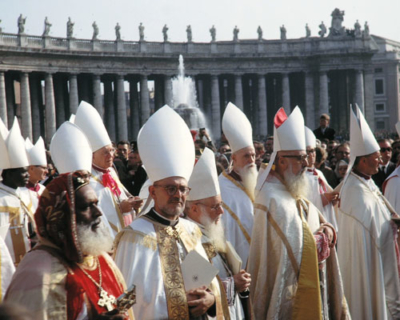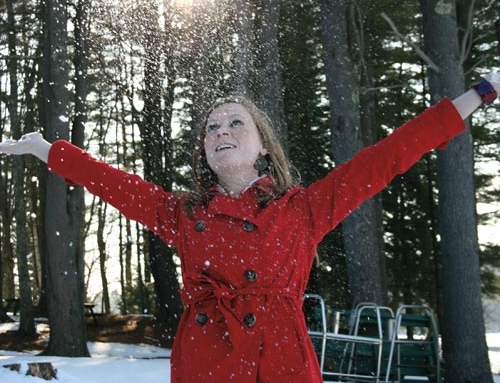 The Second Vatican Council has been called “the most significant religious event since the 16th-century Reformation and certainly the most important of the 20th century.” Why? Because it allowed the Catholic Church to rediscover its deeper identity. Yes, the Church is a hierarchical institution, but it’s also a sacrament, a mystery, a servant of the poor and a pilgrim people. It is empowered by the Holy Spirit to bring the light of Christ to all people. The baptized people of God share in the priestly, prophetic and kingly work of Jesus Christ. Therefore, they labor to end the tragic scandal of the disunity of Christians. Christian unity, although still distant, would be a victory for Christ and for the truth.
The Second Vatican Council has been called “the most significant religious event since the 16th-century Reformation and certainly the most important of the 20th century.” Why? Because it allowed the Catholic Church to rediscover its deeper identity. Yes, the Church is a hierarchical institution, but it’s also a sacrament, a mystery, a servant of the poor and a pilgrim people. It is empowered by the Holy Spirit to bring the light of Christ to all people. The baptized people of God share in the priestly, prophetic and kingly work of Jesus Christ. Therefore, they labor to end the tragic scandal of the disunity of Christians. Christian unity, although still distant, would be a victory for Christ and for the truth.
It started on January 25, 1959, when to the astonishment of many and dismay of some, Pope John XXIII unexpectedly called this 21st Ecumenical Council. Its proximate task was renewing the Church’s life, teaching and organization; its ultimate goal was restoring Christian unity. Preparation took three years.
Pope John opened the Council on October 11, 1962, and Pope Paul VI closed it on December 8, 1965. An intense experience, 2,600 bishops attended the Council, assisted by 450 theological experts. Eighty non-Catholic observers attended. Fifty-two lay Catholics attended: 29 men, 23 women and 10 sisters. Paul VI, John Paul I, John Paul II and Benedict XVI all attended the Council and were deeply committed to its proper interpretation and implementation. Pope Francis continues the renewal of the Church based on the Council.
Vatican II was an incomparable blessing for the Church – its effects were immense. For the Mass, English and other vernacular languages replaced Latin and liturgical texts were revised; communion was shared in the forms of both bread and wine. At the international, national and parish levels, friendly relations with other Christians were promoted; the Church’s social teaching was emphasized; the permanent diaconate open to married men was re-established; and three non-Italians, Karol Wojtyla from Poland, Joseph Ratzinger from Germany, and Jorge Bergoglio from Argentina, were elected popes John Paul II, Benedict XVI and Francis between 1978 and 2013.
Through the Years
1962
At the Council, the bishops struggled with the curia – the bureaucracy at Rome – for control of procedures, a struggle that continued to the end. Progressive bishops established a working majority that chose the path of deep renewal. Pope John XXIII died on June 3, 1963. Pope Paul VI, elected June 21, continued the Council on the course set by Pope John XXIII and the progressive majority of bishops.
1963
During the second session, President John F. Kennedy was assassinated, and his funeral Mass was still celebrated in Latin. The majority of bishops supported collegiality of the bishops, the sacramental role of bishops and restitution of the permanent diaconate. The Constitution on the Sacred Liturgy and the Decree on Social Communication were promulgated.
1964
In the third session, the Dogmatic Constitution on the Church, the Decree on Ecumenism and the Decree on the Eastern Catholic Churches were promulgated. The first changes in the celebration of the Mass were introduced.
1965
In the fourth session, reflecting the Church’s new commitments, Pope Paul VI visited the United Nations and dramatically pleaded for peace. Numerous decrees were heralded in: the Decree on the Bishop’s Pastoral Office, the Decree on the Renewal of Religious Life, the Decree on Priestly Formation, the Declaration on the Relationship of the Church with Non-Christian Religions, the Dogmatic Constitution on Divine Revelation, the Decree on the Apostolate of the Laity, the Declaration on Religious Freedom, the Decree on the Ministry and Life of Priests, the Decree on the Church’s Missionary Activity, and finally the Pastoral Constitution on the Church in the Modern World.
Despite its achievements, Vatican II was followed by unintended, almost wholly unexpected, negative consequences, and it is not always clear why these collateral damages followed. Vocations to the priesthood and religious life collapsed in many areas. Tens of thousands of priests and nuns left their active ministry. Authority was questioned, and freedom was sometimes restricted. New forms of theology, some in radical discontinuity with the Council, arose. Now, the cultures of Europe and North America are largely secular, and a culture of relativism reigns.
Ironically, a large-scale decline in Mass attendance went hand-in-hand with the reform of the Liturgy. Menu Catholicism emerged. Thus, the interpretation of the Council’s 16 documents for many is still unsettled.
Did the Council come too soon, as some have said? Twenty years later the Church may have been better prepared for renewal.
Or did the Council come too late? Ten years earlier, the Church would have avoided confusing the Council’s renewal with the cultural chaos of the 1960s. For true renewal, following the letter and the spirit of Vatican II, four things are necessary. First, charity and pastoral care are foremost. Second, the true path of renewal is grasped only in communion with the whole Church. Third, patience with delays is absolutely necessary. Finally, the Church needs to live in contact with its deepest tradition. Thus, under the guidance of the Holy Spirit, the full renewal of the Church initiated by Vatican II will come to be.
by Dr. Daniel P. Sheridan
Dr. Daniel P. Sheridan is a professor of theology at Saint Joseph’s College.
Vatican II: 50 Years Later
Saint Joseph’s College is commemorating this anniversary with a series of annual symposia, matching the Council’s four annual sessions from 1962 to 1965. The three symposia, Vatican II: 50 Years Later, will gather scholars from the College and from the Diocese of Portland to discuss and assess the successes and failures of this great venture of the Holy Spirit.
The first symposium occurs on October 23, 2013, from 8 a.m. until 5 p.m. in Harold Alfond Hall. The Very Rev. Msgr. Charles Murphy will give the Plenary Address, Blessed John XXIII and the Origins of Vatican II. Topics covered include The 20th Century Liturgical Movement, Apostolic Activity of the Laity, The Church as Sacrament of Union and Unity, and more. For further information, contact Dr. Patricia Ireland at pireland@sjcme.edu.
